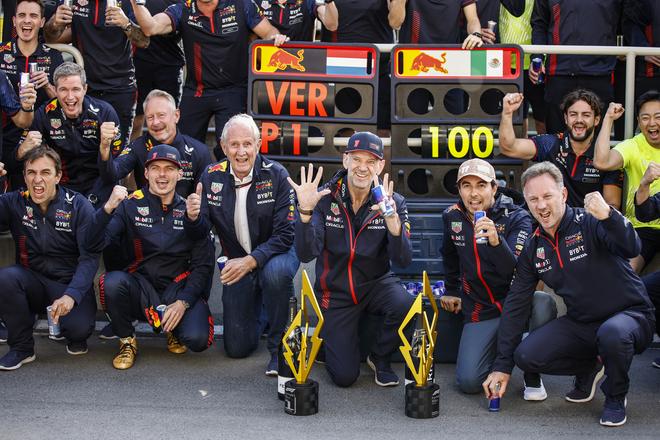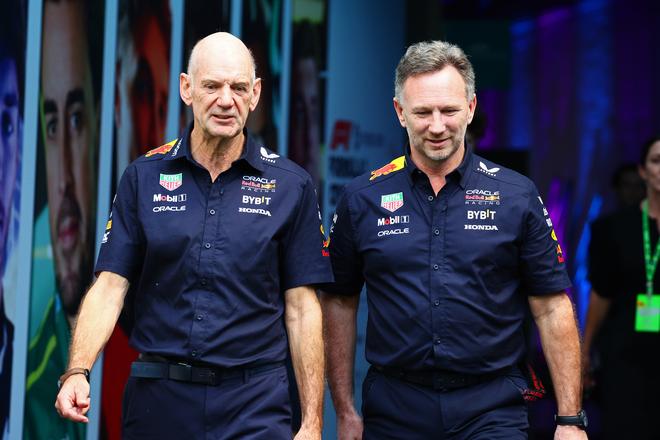Formula One’s silly season usually only buzzes around mid-term, with driver contracts being negotiated during the summer break. But this year, things have been on overdrive from the start.
It began when Lewis Hamilton announced he would leave Mercedes and join Ferrari in 2025. Subsequently, there has been a lot of speculation surrounding Carlos Sainz’s landing spot and even some smoke signals of Merc trying to audaciously poach Max Verstappen from Red Bull.
Coming to a boil
But even as all this played out, a more significant event was brewing under the surface. It concerned the future of Red Bull’s chief technical officer, Adrian Newey. Last week, ahead of the Miami Grand Prix, it was announced that the design genius would leave the team next year.
If Hamilton’s move is seismic in its impact and shock value, Newey’s departure is much more significant, in terms of its potential effect on the pecking order.
The 65-year-old is arguably the best F1 car designer ever, having won championships at three different teams — Williams, McLaren, and Red Bull — in a career spanning over four decades.
Newey has been instrumental in Red Bull becoming the force it is. Drivers are the stars of the show, but results in F1 are decided more by the quality of the machinery at their disposal. A Hamilton or Verstappen can probably put the 2024 Alpine or Sauber a few places higher than where they are placing. But those cars won’t win races even in their brilliant hands. The machinery determines 80-90% of a team’s success, the driver brings in the last 10-20%.
More than the engine horsepower and the mechanical platform, a car’s performance potential is determined by its aerodynamics and downforce. And in F1, no one understands this cryptic art of physics better than Newey, the sport’s foremost aerodynamicist who has revolutionised the subject across an ever-changing technical landscape.
It is famously said, tongue-in-cheek, that Newey can visualise airflow over the car and find the ideal solutions to achieve aerodynamic efficiency; such is his command of the subject.
In a highly complex sport with many variables, Newey’s presence is the closest guarantee of success. He played a crucial role in Williams’ dominance of the constructors’ championship in the ’90s, and his designs powered Nigel Mansell (1992), Alain Prost (1993), Damon Hill (1996), and Jacques Villeneuve (1997) to the drivers’ title.
Priceless ability
The British engineer is known for his priceless ability to examine a new set of regulations and identify which facet of the car will be vital to unlocking maximum performance.
In 1998, F1 moved to narrow-track cars and grooved tyres, and his work in nailing those regulations in his first year at McLaren helped Mika Hakkinen win the titles in 1998 and 1999.
Similarly, in 2009, under a new aero regulation regime, Red Bull jumped from being a lower-mid-grid team to one fighting for the title and dominated the sport from 2010 to 2013, as Sebastian Vettel won four titles on the bounce. The team perfected the concept of blowing exhaust gases through the diffuser — an aerodynamic part in the car’s rear — to generate downforce.
Although Newey has reduced his day-to-day involvement in recent years, he is still the guiding force. In 2022, when the current ground-effect regulations were introduced, he fell back on his work in this area in his early years in the sport to ensure Red Bull hit the ground running.
He realised that getting the suspension right would be critical to performance and focused his efforts on that. Most teams suffered from a problem called porpoising, in which the cars violently bounced on the track, costing lap time and causing discomfort to the drivers. Red Bull managed to mitigate this to a great extent, while a team like Mercedes continues to struggle.
The suspension and the intricate floor design to maximise ground effect have laid the foundation for the side’s dominance of the sport since then.
Modern-day F1 teams are enormous operations with hundreds of highly qualified engineers and the latest tools. But the presence of someone like Newey, who has also worked as a race engineer, adds considerable value, as he understands what the driver needs.

Red Bull has been blessed in that it has managed to get the best out of Newey by giving him complete freedom since he joined the organisation in 2006. He has responded by delivering 13 titles (seven drivers’ and six constructors’) and more than 100 wins.
This tally could further increase. The reigning champion has a baked-in advantage this year — it will likely win both titles and will probably still be competitive next year, as the regulations are stable. However, the team’s biggest challenge begins now. How it handles the transition could determine the future of the energy-drink giant in the sport.
In recent times, the team has learnt to depend less on Newey, but losing such an influential figure is a massive blow as it always had the cushion of relying on him to troubleshoot any problem. More importantly, his exit couldn’t have come at a worse time.
Life after Newey
In 2026, a fresh set of regulations will come into force, and it will be the first time Red Bull will approach them without Newey illuminating the path. To add to the challenges, Red Bull will also be building its own power units starting in 2026, which is a huge undertaking, considering it is not an original equipment manufacturer.
Becoming a championship-winning team doesn’t happen overnight, even with a blank cheque. There are no silver bullets for instant success, and it takes a lot of years to get the structure right. In Red Bull’s case, the period from 2006 to 2008 allowed Newey to put things in place. That foundation was vital to tackling the ’09 regulations, which helped it jump to the front of the grid.

The big test now will be to see how robust that structure is without its chief architect at the helm. Recently, it emerged that Newey felt team boss Christian Horner was downplaying his contributions in public. Newey hasn’t commented on this, but his wife’s social media posts hinted at it, which seems to have played a part in his decision to quit.
Horner has also been in the eye of the storm this year after a female employee accused him of harassment but he was cleared of wrongdoing after an internal investigation. The situation created a sense of unease in the team, and McLaren team boss Zak Brown even hinted that some Red Bull employees were shopping their CVs around.
The significant risk, though, pertains to Verstappen’s future. The Dutchman wasn’t happy with what was happening inside the team either. Could Newey’s exit push him over the edge at a time when Mercedes is openly courting him?
It only takes a little for a team to crumble from a position of strength, especially when there is a personnel change at the top. Since Newey’s departure, Williams hasn’t won a title, and McLaren managed just one driver’s title in 2008, which shows how vital he was to those teams. Can Red Bull break the jinx? Only time will tell.







